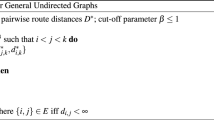Abstract
Two algorithms have been constructed that find the intersections between two sets of line segments in practical networks used for planning and routing, solving the implementation issues of existing algorithms. One of the algorithms is a generalisation of the Bentley-Ottmann-algorithm, relaxing the assumptions in the original algorithm, the other is a smart brute force algorithm. In this article the algorithms are elaborated and will be tested, using real data sets constructed from street networks and trench networks. Both algorithms find all the intersections but with a difference in calculation time.
Access this chapter
Tax calculation will be finalised at checkout
Purchases are for personal use only
Similar content being viewed by others
Notes
- 1.
Intersection means intersection in the two dimensional projection.
- 2.
Note that the Bentley-Ottmann-algorithm is output-sensitive, meaning that the complexity and therefore the running times depend on the size of the output.
References
Agarwal, P.K., Sharir, M.: Red-blue intersection detection algorithms, with applications to motion planning and collision detection. SIAM J. Comput. 19(2), 297–321 (1990)
Arge, L., Mølhave, T., Zeh, N.: Cache-oblivious red-blue line segment intersection. In: Halperin, D., Mehlhorn, K. (eds.) ESA 2008. LNCS, vol. 5193, pp. 88–99. Springer, Heidelberg (2008). doi:10.1007/978-3-540-87744-8_8
Balaban, I.: An optimal algorithm for finding segments intersections. In: Proceedings of the Eleventh Annual Symposium on Computational Geometry, SCG 1995, pp. 211–219. ACM, New York (1995)
Bentley, J., Ottmann, T.: Algorithms for reporting and counting geometric intersections. IEEE Trans. Comput. 28(9), 643–647 (1979)
Chazelle, B., Edelsbrunner, H.: An optimal algorithm for intersecting line segments in the plane. J. ACM 39(1), 1–54 (1992)
Clarkson, K., Shor, P.: Applications of random sampling in computational geometry, II. Discret. Comput. Geom. 4(5), 387–421 (1989)
Mantler, A., Snoeyink, J.: Intersecting red and blue line segments in optimal time and precision. In: Akiyama, J., Kano, M., Urabe, M. (eds.) JCDCG 2000. LNCS, vol. 2098, pp. 244–251. Springer, Heidelberg (2001). doi:10.1007/3-540-47738-1_23
Mes, M.R., Iacob, M.E.: Synchromodal transport planning at a logistics service provider. In: Zijm, H., Klumpp, M., Clausen, U., ten Hompel, M. (eds.) Logistics and Supply Chain Innovation, pp. 23–36. Springer, Heidelberg (2016)
Moore, B.: Data structures (2014). http://www.mathworks.com/matlabcentral/fileexchange/45123-data-structures
Mulmuley, K.: A fast planar partition algorithm. I. In: 2013 IEEE 54th Annual Symposium on Foundations of Computer Science, pp. 580–589 (1988)
Phillipson, F.: Efficient algorithms for infrastructure networks: planning issues and economic impact. Ph.D. thesis, VU Amsterdam (2014)
Sedgewick, R., Wayne, K.: Algorithms, 4th edn. Addison-Wesley, Boston (2011)
Shamos, M., Hoey, D.: Geometric intersection problems. In: 2013 IEEE 54th Annual Symposium on Foundations of Computer Science, pp. 208–215 (1976)
SteadieSeifi, M., Dellaert, N.P., Nuijten, W., Van Woensel, T., Raoufi, R.: Multimodal freight transportation planning: a literature review. Eur. J. Oper. Res. 233(1), 1–15 (2014)
Author information
Authors and Affiliations
Corresponding author
Editor information
Editors and Affiliations
Rights and permissions
Copyright information
© 2017 Springer International Publishing AG
About this paper
Cite this paper
Neumann, N., Phillipson, F. (2017). Finding the Intersection Points of Networks. In: Eichler, G., Erfurth, C., Fahrnberger, G. (eds) Innovations for Community Services. I4CS 2017. Communications in Computer and Information Science, vol 717. Springer, Cham. https://doi.org/10.1007/978-3-319-60447-3_8
Download citation
DOI: https://doi.org/10.1007/978-3-319-60447-3_8
Published:
Publisher Name: Springer, Cham
Print ISBN: 978-3-319-60446-6
Online ISBN: 978-3-319-60447-3
eBook Packages: Computer ScienceComputer Science (R0)




